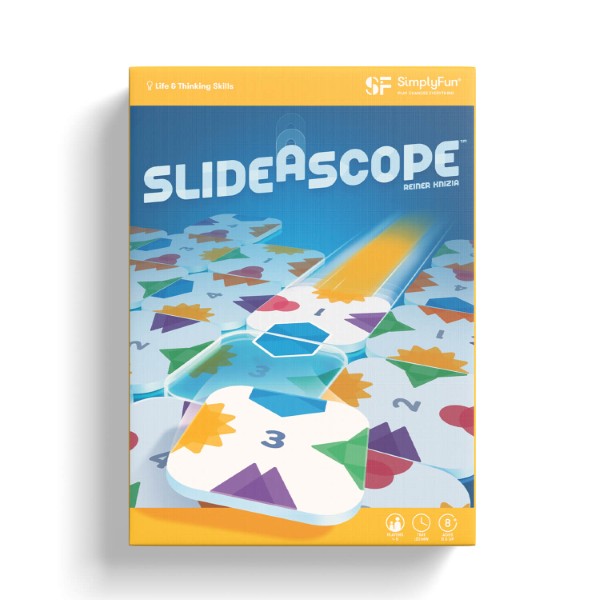
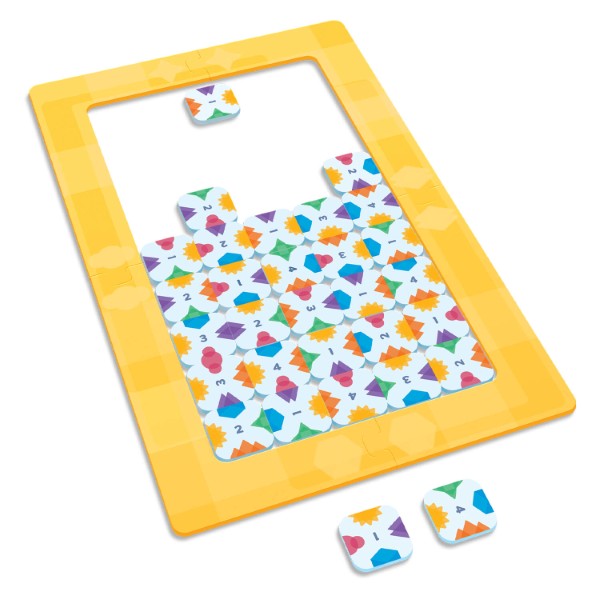


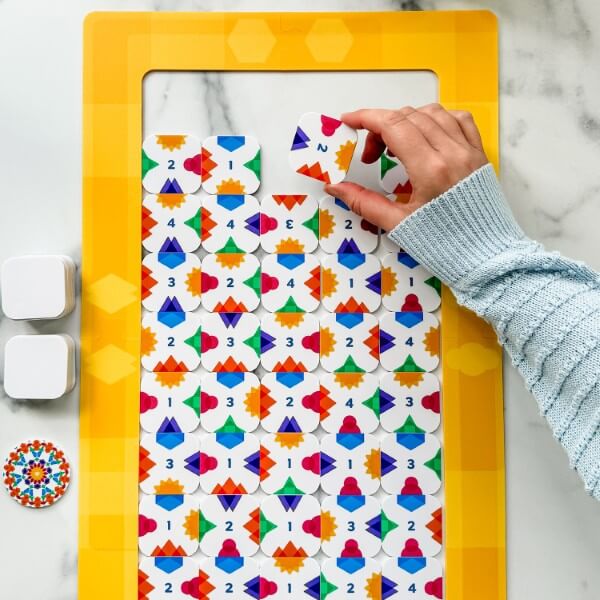
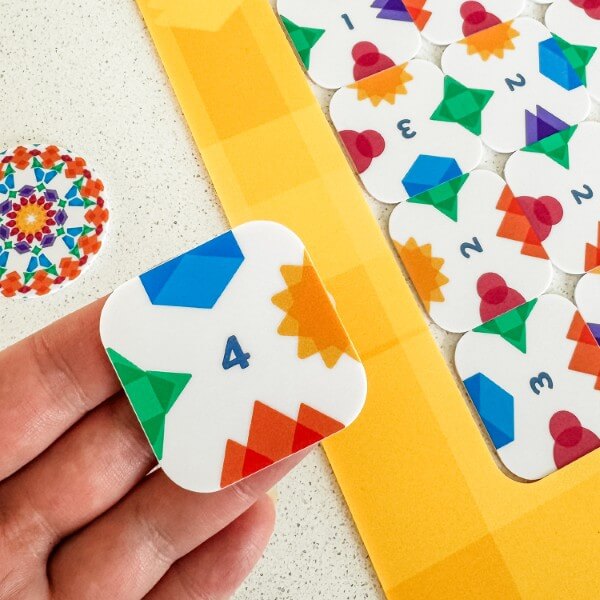
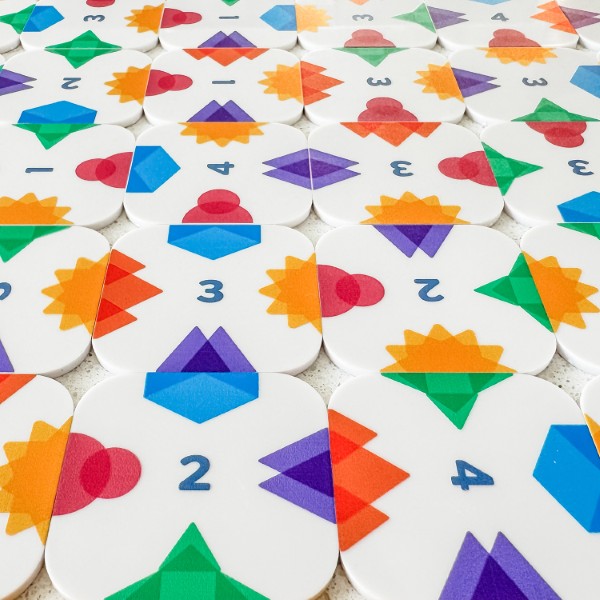






Collapsible content
You can play SlideAscope with 1-5 players, ages 8 and up!
SlideAscope is great for practicing Spatial Reasoning skills as players visualize and manipulate their tiles to understand the various options when placing and rotating their tiles with the goal of creating matches.
SlideAscope also helps develop Critical Thinking skills as players analyze and evaluate the playing field to determine where to best place their tiles.
Assemble the four puzzle pieces of the frame by matching the printed shapes at each connection point. Place the frame in the middle of the play area.
Mix up the tiles in the storage bag.
To determine who will go first, each player draws two tiles from the bag and adds the numbers together. If there is a tie, the tied players draw again. The player with the highest sum goes first. Hand them the starting token. Then place all the tiles back in the bag.
Pull tiles one at a time to create a 5 x 8 grid of 40 tiles inside the frame, allowing the orientation of the tiles to be completely random. Numbers will be facing in all directions and it's ok if shapes sometimes match up. This grid will be different each time you play!
With the remaining tiles, create several face-down draw piles where everyone can reach. Place the storage bag back in the box.
Each player draws one tile from a draw pile and keeps it hidden from the other players.
Players take turns scoring as many points as possible each turn by matching the sides of the placed tile to the sides of the tiles in the playing field. As tiles are matched and collected, the remaining tiles above will slide down, possibly creating more matches and earning you more points. The player with the most points at the end of the game wins!
TILES AND SHAPES
The center of each tile is numbered 1 through 4 for scoring at the end of the game. Around the outside of each tile are a selection of half-shapes. There are six half-shapes in the game. Your goal is to place a tile to match two identical halves of a shape to create a whole shape. Then, collect the tile you matched, leaving the tile you placed.
FRAME AND PLAYING FIELD
The frame contains the tiles in the playing field. The empty row at one end of the playing field marks the top of the frame. Tiles always slide from the top of the frame toward the bottom for all players, no matter where they sit in relation to the frame.
All players use the same orientation to check matches, no matter where they sit in relation to the frame, to ensure the tiles always slide in the same direction.
PLACING YOUR TILE
On your turn, look at your tile and the tiles in the playing field to see what matches you can make. You may rotate the tile in your hand to help you visualize all the options. Once you have decided, place your tile at the top of one of the five columns.
NOTE: If you cannot make a match, show the tile to the other players and place it on the bottom of a draw pile. Then draw a new tile. Continue your turn by placing the new tile in the playing field.
After placing your tile, check the left side. If the existing tile has a matching half shape on the side touching your placed tile, collect it by removing that tile from the playing field. The tile you placed stays in the playing field. Next, slide any tiles above the collected tile down to fill in the empty space. Now check if the new tile next to your placed tile matches. If it does, collect the new tile, slide the above tiles down and repeat.
If the tile does not match, look to the right side of your placed tile. If the existing tile has a matching half shape, collect that tile from the playing field and slide any above tiles down to fill in the empty space. Continue the process of checking and collecting until there are no more matches to the left and right.
If there are no more matches on the left and right side, look at the tile in the row below your placed tile. If that side of your tile matches, collect the existing tile and slide your tile down the column to fill in the empty space. Once your tile moves to its new location, check left, right and below again. Continue checking around your tile until there are no more matches.
ROTATING YOUR TILE
Starting with your second turn, all players have the option to rotate their placed tile to create additional matches. Once you place your tile and collect all matching tiles, you may rotate during that same turn. To do this, you need to first discard one of your collected tiles (usually a lower point value) by placing it face up into a discard pile near the draw piles (J). Then you may rotate your tile once to any new orientation within the same space (K). After you have rotated your tile, collect any matches to the left, right, or below (L) and slide any tiles above to fill in the space. After collecting all possible matches, your turn ends. You may only discard and rotate once per turn.
NOTE: As tiles slide down, they may create matches with other tiles, but ONLY the matches that touch your placed/rotated tile count. Any matches created by tile movements not touching your placed tile are ignored and those tiles stay in the playing field.
ENDING YOUR TURN
Keep your collected tiles stacked in front of you until the game ends.
Once you have placed your tile, collected the matching tiles, rotated your tile if you chose to do so and collected any additional tiles, your turn is over. Pick a new tile from a draw pile, and it is the next player’s turn.
The game end is triggered when all the tiles in one or more of the five columns are removed. If the next player is the starting player, the game ends. If not, all remaining players take one more turn and the game ends before the starting player's next turn.
SCORING
After all players have their final turn, everyone adds up the total points on their collected tiles.
The player with the highest score wins!
Consider arranging your collected tiles in groups by points or, if possible, in groups of two with a sum equal to 5 to make it easier to add up your score.
If there is a tie, count the number of tiles. The tied player with the most tiles wins. If there is still a tie, the player with the most number 4 tiles wins.
See how many shapes you can match when you play SimplyFun’s SlideAscope.


Core Standard*: Math
Math
- Operations and Algebraic Thinking
- Add and subtract within 20. : Grade Level 2nd
- Work with equal groups of objects to gain foundations for multiplication. : Grade Level 2nd
- Number & Operations in Base 10
- Understand place value. : Grade Level 2nd
- Use place value understanding and properties of operations to add and subtract. : Grade Level 2nd
- Geometry
- Reason with shapes and their attributes. : Grade Levels 2nd, 3rd


Explore
What Does Child Do To Use Skill In The Game?
On their turn, a player needs to look closely at the game board to find options for playing a tile to maximize point scoring.
How Parents Can Assist Learning
If you notice a child is playing tiles with lower scores than possible, revisit the instructions which set forth a 3-stage sequence to follow for visualizing scoring options. Also, remind children to look at the point value of tiles, not just whether they can make a matching shape.
Learning Implications and Educator Support
SlideAscope involves a lot of spatial visualization, spatial reasoning, sequencing and analysis. In the game, these skills simultaneously involve exploring, comparing, determining and planning in order to chose what tile to play and how to rotate it to score the most points.
If you notice a child is playing tiles with lower scores than possible, revisit the instructions which set forth a 3-stage sequence to follow for visualizing scoring options. Also, remind children to look at the point value of tiles, not just whether they can make a matching shape.
Determine
What Does Child Do To Use Skill In The Game?
As a player considers which tiles to play where and in which orientation, they are finding out what the possible scores are for each option. After comparing options, they decide on which is the best tile, location and orientation to make their play.
How Parents Can Assist Learning
See Explore
Learning Implications and Educator Support
See Explore
Compare
What Does Child Do To Use Skill In The Game?
Players will compare the options for playing a tile to maximize their score.
How Parents Can Assist Learning
It may help for a child to write down the scoring of different options as they consider which tile to place and in which orientation.
Learning Implications and Educator Support
SlideAscope is excellent for developing comparison skills that involve compound variables, such as point values, matching shapes and sequential planning.
Educators may want to ask a player on their turn to describe the options they are evaluation. This may reveal areas of strength or weakness in the child's thinking that can be discussed and, if needed, improved.
Predict
What Does Child Do To Use Skill In The Game?
Players need to think about what will happen when they make a matching shape which will cause other tile(s) to move, and what will happen when they rotate their tile.
How Parents Can Assist Learning
It may help younger children to hold their tile over the game board to assist with visualizing what matches can be made and what will happen when matching tiles are removed.
Learning Implications and Educator Support
Like games from checkers to chess, SlideAscope requires children to use spatial reasoning and sequencing skills to predict what will happen to other elements on the game board when they play their and rotate their tile.
Educators may need to encourage children to hold and reorient their tiles over the game board to assist with thinking through what will happen if they play a tile in a specific location.
Plan
What Does Child Do To Use Skill In The Game?
In SlideAscope, planning is intertwined with predicting as players think about possible sequences of tile movements and shape matches based on where they can play one of their tiles to start a turn.
How Parents Can Assist Learning
It may help younger children to hold their tile over the game board to assist with visualizing what matches can be made and what will happen when matching tiles are removed.
It may also help to talk about the options the child is considering to help them strengthen their prediction and planning implications.
Learning Implications and Educator Support
Like games from checkers to chess, SlideAscope requires children to use spatial reasoning and sequencing skills to predict what will happen to other elements on the game board when they play their and rotate their tile.
Educators may need to encourage children to hold and reorient their tiles over the game board to assist with thinking through what will happen if they play a tile in a specific location.
Practice
What Does Child Do To Use Skill In The Game?
Like other strategy games, the more children play SlideAscope the more they improve their spatial reasoning, sequential thinking, problem-solving, comparison and planning skills. They can also practice these and other skills by playing SlideAscope solo.
How Parents Can Assist Learning
Parent support is not required. However, leaving the game out on a table or boxed up in a visible location may prompt the child to practice it on their own or invite you to play along. SlideAscope is an engaging game for all ages.
Learning Implications and Educator Support
Educator support is not required.
*Data compiled from CCSSI ELA Standards, WA Science Standards, and Washington Social Studies Standards


Cognitive
Suggestions for How to Modify Play Experience
Have players play in pairs.
Team mates can help each other find matches, and support the child in looking at all sides of the placed tile for matches. Prompt turning the tile to look for additional matches.
Modify the game to look for just one matching shape on the tile with the largest number possible.
Cut out large paper shapes (two of each) that match the shape and the color of the shapes on the tiles. When the child draws a tile, show them how the paper shape go together. Ask the player to find a space with a shape that looks like the shape on their tile, so it looks like the two paper shapes joined together. Having the large 1/2 shape will help the child search for one specific shape and color.
Communication
Suggestions for How to Modify Play Experience
Although communication is not needed, encourage labeling the color of the shape that matches their tile.
Label sides of the tile: top, bottom, left, right. Label parts of the shapes: curves, angles, straight edge.
Sensorimotor
Suggestions for How to Modify Play Experience
Sliding the tiles is a fun part of SlideAscope. Picking up the tiles when they are surrounded by other tiles may be problematic for children with fine motor concerns. Let the child use pieces of tape wrapped around a finger to pick up the tiles.
Social Emotional/Behavioral
Suggestions for How to Modify Play Experience
Children who get easily frustrated when they don't see an immediate solution, may need to play with a partner who can assist in the search. Enable the child to pick up and slide the tiles to reinforce their efforts.
Vision
Suggestions for How to Modify Play Experience
SlideAscope is not recommended for children with low vision as it is visually complex.
Hearing
Suggestions for How to Modify Play Experience
Have the child read the directions, if possible. Demonstrate the game play with actions and gestures to point out matches, points, and movement of pieces.
*Data compiled from CCSSI ELA Standards, WA Science Standards, and Washington Social Studies Standards


Autism Strengths & Interests
Short Summary of Strengths & Interests
- Spatial Reasoning
- Strategic Thinking
- Problem-solving
Is good at matching visual items
Is This Game Appropriate? Yes
Description
Matching is the key aspect of SlideAscope.
Has a good memory for sensory details, including visual, touch, taste and smell
Is This Game Appropriate? Yes
Description
Visual scanning is needed to identify the best place to place a tile.
Has a good memory for words, phrases and dialouge
This game is not appropriate
Has a good memory for pictures, numbers and patterns
Is This Game Appropriate? Yes
Description
By combining mirrored shapes, the player creates a new shape. Players have to add all their tile numbers at the end of the game.
Likes to put things in order or a sequence
Is This Game Appropriate? Yes
Description
Tiles are placed in columns and move down the column as tiles are removed. This sequence is followed within every column until one is empty and the game ends. Removal of tiles is accomplished by matching shapes in sequence around the player's tile.
Learns through visualizing or "replaying" actions in their mind
Is This Game Appropriate? Yes
Description
Visualizing is used in SlideAscope when anticipating where tiles will slide when matching tiles are removed. This can help players plan to earn more points.
Likes activities with rules, such as math and phonics
This game is not appropriate
Is very concrete and literal
This game is not appropriate
Learns in small "chunks" (for example, phone numbers are 3 chunks of number xxx-xxx-xxxx that are combined together)
This game is not appropriate
Is good at nonverbal reasoning and logic
Is This Game Appropriate? Yes
Description
Spatial Reasoning is needed in each turn, and logic is needed for strategic play to gain more points.
Likes spatial problem solving
Is This Game Appropriate? Yes
Description
The game is primarily about spatial reasoning. Players need to visualize where to place tiles, what matches may be made when rotating their tile, and where tiles will move after a matching tile is removed. Anticipating where additional matches can be made and where the most points can be earned is part of the strategy of the game.
Can read well with good vocabulary, though may not fully comprehend content
This game is not appropriate
Likes to use and has good fine motor skill
Is This Game Appropriate? Yes
Description
Placing, retrieving, and sliding tiles requires fine motor skills.
Likes established routines or set ways of doing things
Is This Game Appropriate? Yes
Description
Although the board tiles change with each game the game procedures are the same with each turn.
Likes manipulating, constructing or building things
Is This Game Appropriate? Yes
Description
Although not a construction game, the game does require manipulating and deconstructing the board.
Likes to use and has good musical abilities
This game is not appropriate
Likes to use and has good drawing skills
This game is not appropriate
Autism Special Considerations
Appears to ignore other's communication and/or has difficulty giving eye contact to a communication partner
Is This Game Appropriate for Child with Characteristic? Yes
Can Child with Characteristic Play Game w/o Modification? Yes
Strategies for Developing Compensatory Skills:
SlideAscope does not require communication or eye contact. The players do need to watch others moves in order to play strategically.
Has difficulty understanding complex verbal directions
Is This Game Appropriate for Child with Characteristic? No
Can Child with Characteristic Play Game w/o Modification? No
Strategies for Developing Compensatory Skills:
Simplify the directions to leave out the ability to rotate a tile on the second turn and there after. The directions could also be simplified further by having players make a match on only one side of their tile.
Uses vocabulary inaccurately or demonstrates echolalia (repeating another's speech)
Is This Game Appropriate for Child with Characteristic? Yes
Can Child with Characteristic Play Game w/o Modification? Yes
Strategies for Developing Compensatory Skills:
Unless echolalia is keeping other players from concentrating on the game, it should not inhibit play.
Gets stuck repeating a verbal topic or physical actions and/or has difficulty attending to others' actions or topic.
Is This Game Appropriate for Child with Characteristic? Yes
Can Child with Characteristic Play Game w/o Modification? Yes
Strategies for Developing Compensatory Skills:
Players can talk during the game, but need to attend to the moves made by each player to be able to select the best move on their turn.
Has difficulty producing speech/communication
Is This Game Appropriate for Child with Characteristic? Yes
Can Child with Characteristic Play Game w/o Modification? Yes
Strategies for Developing Compensatory Skills:
Players do not need to communicate with each other to play the game, though most will want to talk about their moves. Players need to count up their points and report this, verbally, with sign language, or in writing.
Has difficulty sequencing multi-step actions and/or doing complex abstract tasks
Is This Game Appropriate for Child with Characteristic? No
Can Child with Characteristic Play Game w/o Modification? No
Strategies for Developing Compensatory Skills:
Break down the player's turn into steps and help them visual scan for matches. Once a space is located encourage the child to look at all sides of their tile for additional matches. Omit the rotation option, unless the child is able to visualize the potential match. Determining the total score may be difficult for some, but other players can help if needed.
Demonstrates difficulty initiating and maintaining social interactions
Is This Game Appropriate for Child with Characteristic? Yes
Can Child with Characteristic Play Game w/o Modification? Yes
Strategies for Developing Compensatory Skills:
Social interaction is not needed to play the game, although players have to wait their turn.
Acts out or demonstrates avoidance behaviors when frustrated, overwhelmed, or needs more sensory input.
Is This Game Appropriate for Child with Characteristic? Yes
Can Child with Characteristic Play Game w/o Modification? Yes
Strategies for Developing Compensatory Skills:
If the game is two challenging for the child to play independently, have them play with a partner. Also, a fidget toy may help the child maintain attention.
Has short attention span for non-preferred activities
Is This Game Appropriate for Child with Characteristic? Yes
Can Child with Characteristic Play Game w/o Modification? Yes
Strategies for Developing Compensatory Skills:
Many children with autism enjoy puzzles, so this may be a preferred game. If not playing with a partner may help. If too frustrated by the visual requirements, SlideAscope may not be the best choice of games.
Needs sameness or consistent routines and/or has difficulty with transitions from one activity to another
Is This Game Appropriate for Child with Characteristic? Yes
Can Child with Characteristic Play Game w/o Modification? Yes
Strategies for Developing Compensatory Skills:
If the child likes puzzles, SlideAscope may be a good choice. Although the board changes with each round of the game, the play procedures remain the same.
Has difficulty understanding others' feelings, intentions, and the reasons for others' actions.
Is This Game Appropriate for Child with Characteristic? Yes
Can Child with Characteristic Play Game w/o Modification? Yes
Strategies for Developing Compensatory Skills:
It is helpful to anticipate what another play might do to get a higher score, so a defensive play can be made. The game can be played without this element, however.
*Data compiled from CCSSI ELA Standards, WA Science Standards, and Washington Social Studies Standards


Extra Ways to Play the Game
Play without being able to rotate the tiles.
Materials Needed
No additional materials needed.
Developmental Benefits
Rotating the tiles provides more options for matches. If this option is omitted, the child needs to search more carefully for the best tile to move. This requires visual search and reasoning.
*Data compiled from CCSSI ELA Standards, WA Science Standards, and Washington Social Studies Standards
- Choosing a selection results in a full page refresh.
- Opens in a new window.















